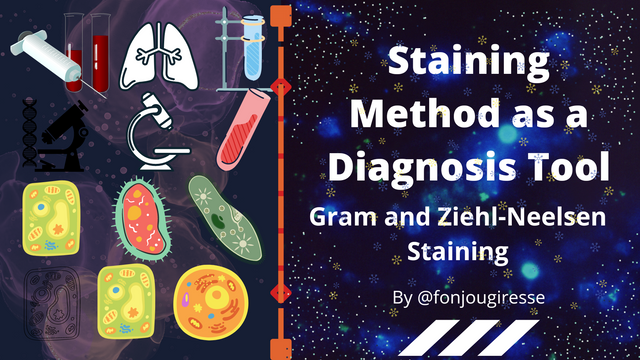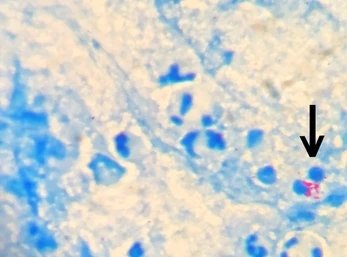[Club100] Diagnosis of Disease Based on Staining Methods
Greetings Steemians Science is a very important aspect of our lives. Thanks to science many people's lives have been saved and it is important to know what is around us more detailly, even at the cellular level. After the diagnosis of disease based on the ultrastructure, here I come with the diagnosis of disease based on Staining Methods.

Designed on Canva by @fonjougiresse
Staining Based Methods:
Gram Staining
Discovered by Hans GRAM in 1884, it is based on structural differences in the walls of bacteria. It allows one to distinguish G+ bacteria colored in purple from G-bacteria colored in pink or red. We can know the presence of the bacteria, which guides the diagnosis. This technique can therefore help us diagnose certain bacterial diseases such as: food poisoning due to Bacillus (gram+), gastroenteritis due to Escherichia coli (gram-).
Ziehl-Neelsen Staining
It allows the identification of mycobacteria under the microscope. It is one of the stains that highlights acid-alcohol resistance, a fundamental characteristic of mycobacteria, taking into account the difficulty of penetrating the stains. When observed, mycobacteria appear as red bacilli on a blue-grey background.

Source The arrow on the picture indicate the presence of Mycobacterium tuberculosis, which appears as a pink stain on the slide
This technique allows us to diagnose certain diseases such as tuberculosis (due to Mycobacterium tuberculosis) and leprosy (due to Mycobacterium leprae).
Methods based on Affinity
Immunochemical tests can also be used.
These tests are based on antigen-anticorp reactions. Membrane antigens are used, present on the surface of plasma membranes, like the O antigen on certain gram negative bacteria, and the specific monoclonal antibody is placed in the presence of the antigen and the formation of agglutination is observed, which may indicate the presence of a bacterial cell.
An example: blood grouping
To determine the blood group, we use the AGGLUTINATION TEST. This technique joins the methods of precipitation and cytolysis: it is an agglutination of particles which is the result of a reaction of Antibodies (Ab) directed against Antigens (Ag) present on the surface of the particle (red globule, ball of latex). The result is visible to the naked eye. An antibody against hexaglycosylceramide, an antibody against acetylgalactosamine, and a mixture of both are used. In a test, if you are group A, your red blood cells clump with anti-A; if you are group B, your red blood cells clump with anti-B. Human blood group antigens differ by the nature of their membrane carbohydrates.
That's all for today. Please follow for more updates.
Best regards
@fonjougiresse
Upvoted! Thank you for supporting witness @jswit.

Please check my new project, STEEM.NFT. Thank you!
Note: You must enter the tag #fintech among the first 4 tags for your post to be reviewed.
Thanks very much @kouba01. I'll continue to do my best